MARIANI’S
Virtual
Gourmet
September 5,
2021
NEWSLETTER
Founded in 1996
ARCHIVE
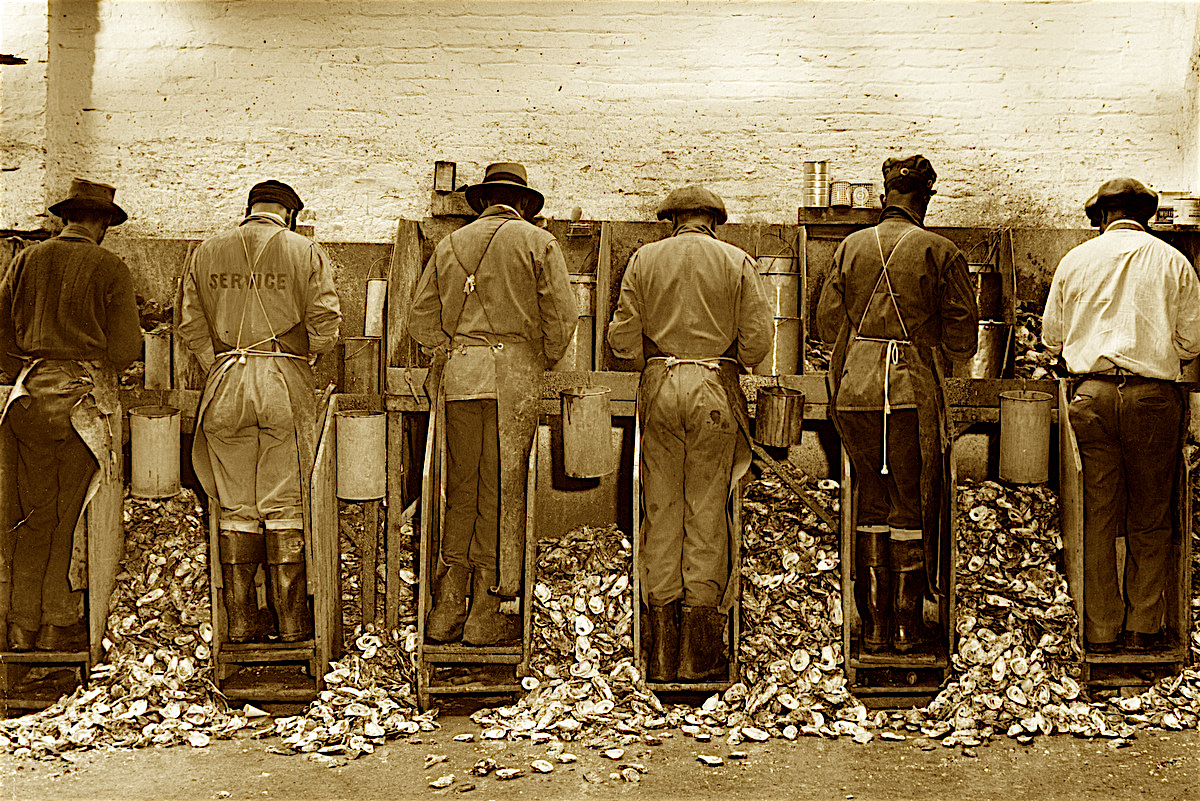
"Oyster Shuckers, Rockpoint, Maryland" (1936) by Arthur Rothstein
IN THIS ISSUE
A PERFECT RESTAURANT
By John Mariani
NEW YORK CORNER
VICTOR'S CAFÉ
By John Mariani
CAPONE'S GOLD
CHAPTER 23
By John Mariani
NOTES FROM THE WINE CELLAR
SUSTAINABILITY NOW THE
RULE IN WINEMAKING
By John Mariani
❖❖❖
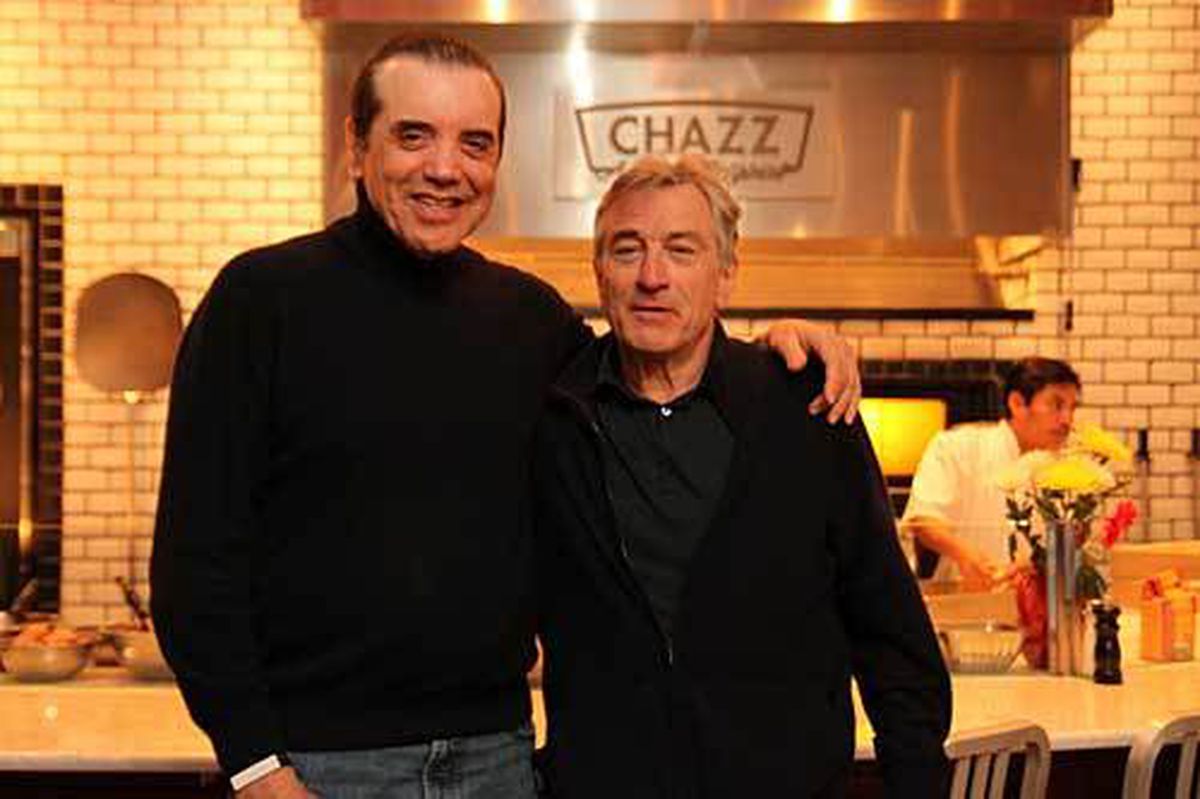 PALMINTERI, author
of A BRONX TALE. Go to: WVOX.com.
The episode will also be archived at: almostgolden.
PALMINTERI, author
of A BRONX TALE. Go to: WVOX.com.
The episode will also be archived at: almostgolden.
❖❖❖
A PERFECT RESTAURANT
By John Mariani
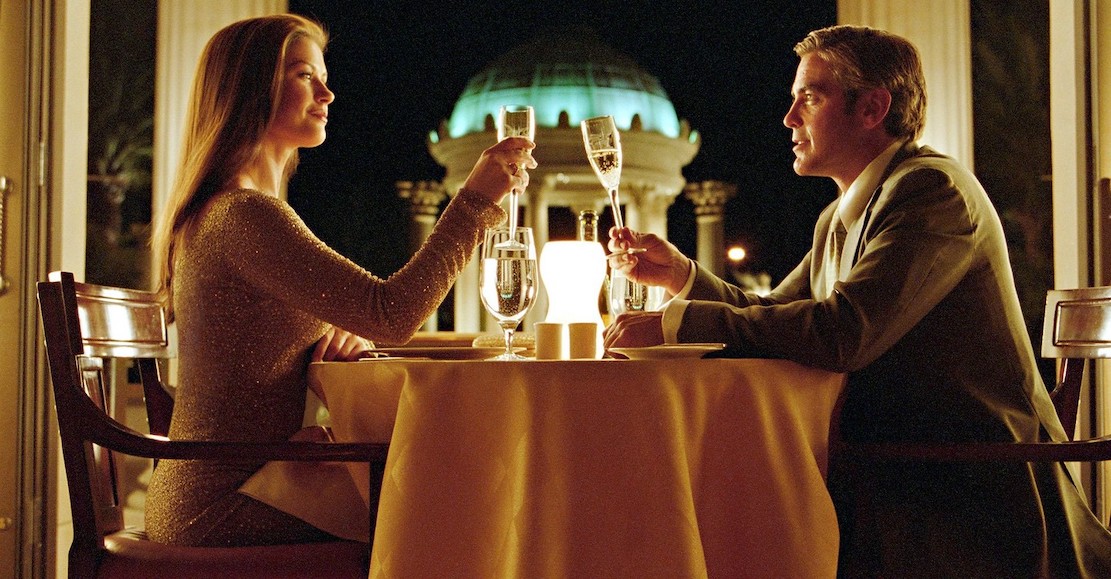
• Décor—The last thing I expect is the kind of old-fashioned French kitsch that looks like the set of a Hollywood musical about Marie Antoinette. Modern décor offers so many beautiful options for a restaurateur to choose from, so that an haute cuisine restaurant in Paris might very well be a model of modernism. It is in the use of materials and interior design that expresses the style and essence of a good restaurant, not the gilding on its sconces or the tassels on its menu.
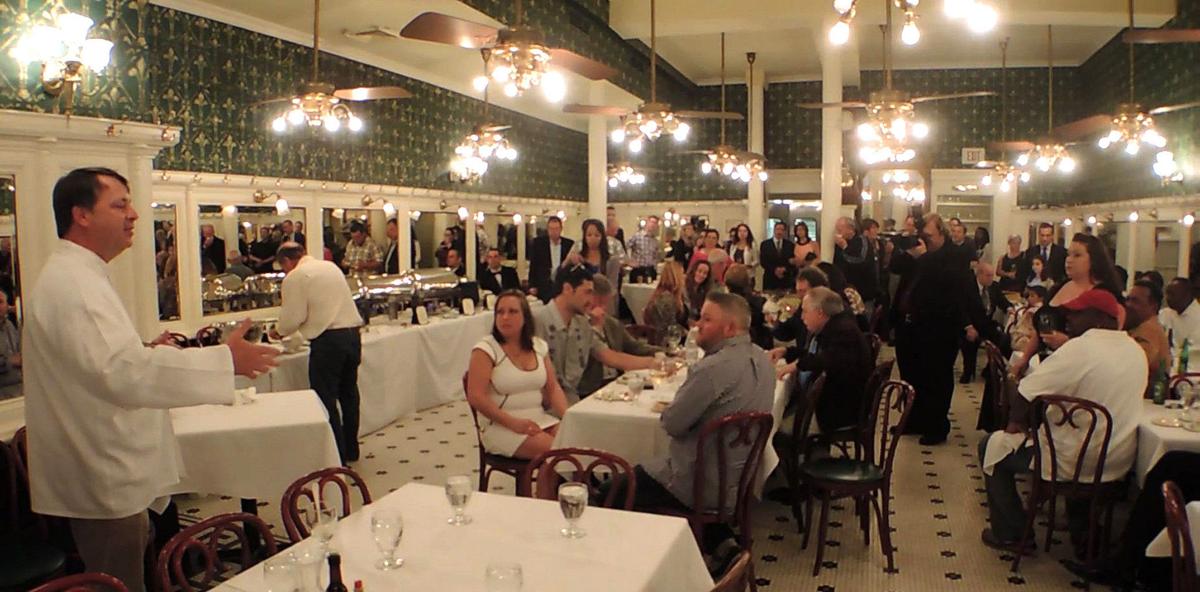 •
Lighting—I deplore the idea that dark,
dim lighting is in any way romantic, unless it’s by
candlelight in a wine cellar. And in fact, most of
the great restaurants of the world tend to have lots
of light, so as to show off the décor, the beauty of
the table settings and food and the opportunity for
people to see each other across a room, as
Galatorie's in New Orleans (left). Harsh
lighting is inexcusable but soft lighting is
requisite for conviviality. Otherwise, in a dark
room, you find people whispering, “Will you please
pass the salt,” then fumble to distinguish the salt
shaker from the pepper. Again, modern light
fixtures, recessed or tracked, offer all sorts of
mood-lifting light.
•
Lighting—I deplore the idea that dark,
dim lighting is in any way romantic, unless it’s by
candlelight in a wine cellar. And in fact, most of
the great restaurants of the world tend to have lots
of light, so as to show off the décor, the beauty of
the table settings and food and the opportunity for
people to see each other across a room, as
Galatorie's in New Orleans (left). Harsh
lighting is inexcusable but soft lighting is
requisite for conviviality. Otherwise, in a dark
room, you find people whispering, “Will you please
pass the salt,” then fumble to distinguish the salt
shaker from the pepper. Again, modern light
fixtures, recessed or tracked, offer all sorts of
mood-lifting light.• Noise Level—The bane of contemporary restaurants, especially in the U.S., is a dining room whose decibel level of 90+ is the same as having a lawnmower go through it. In fact, many restaurateurs are under the delusion that noise, with added piped-in music, creates excitement, when all it does is to encourage more noise, impossible conversation and intense stress. Sonically speaking, 65 decibels is considered to be “normal conversation,” which sounds just fine to me.
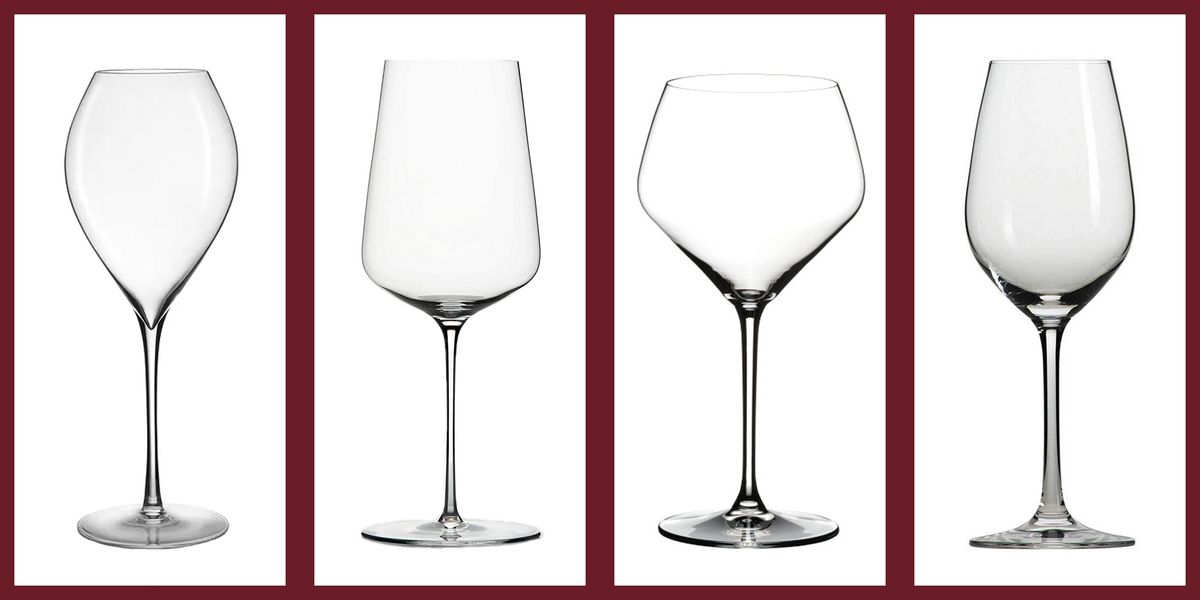
• Napery, silverware, glassware—Whatever is put on the table should reflect the same style and class of what surrounds it, so there should be some sort of amenable and appealing table covering (bare tables has become the rule these days out of a desire to cut costs). The silverware need not be Cristofle or Laguiole, but it should not be cheap diner-class either. Excellent, thin glassware these days is extremely inexpensive and, even cheaper for restaurants buying in bulk, because of imports from Eastern Europe, so that it is wholly unacceptable to have wineglasses with thick stems and lips on the rims.
• Wine list—I am much happier with a moderate-size, well selected wine list than a phone book (are there still such things?) of trophy wines with sixteen California Merlots and ten vintages of a duxième cru Bordeaux. And I see little reason for an Italian restaurant to stock Australian Sauvignon Blancs or Greek restaurants to cellar South African carménères. Give me a list geared to the menu and have a beverage director who is helpful rather than pushy. A good sommelier should ask if you wish to have the bottle left on the table so you can pour it at will. Ice buckets should be set within reach. Decanting need only be done for older wines known to throw off sediment.
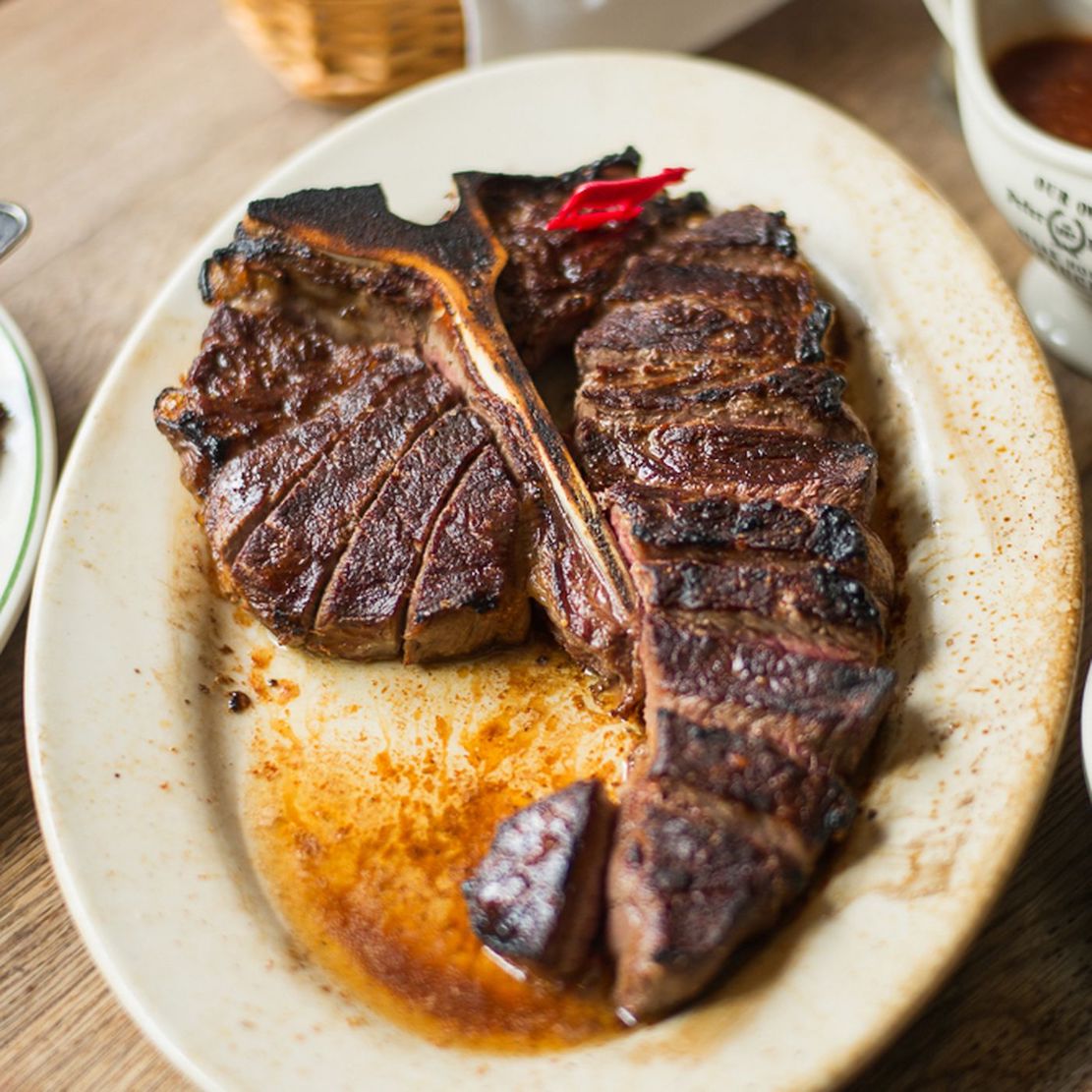 •
Wine temperature—This is
critical, although one need not be draconian about
it. A red wine at 55 degrees and white wine around
ten degrees cooler are ideal, but if your "room
temperature" us above 75 or you white wines are
chilled ice cold, wine should always err on the side
of coolness.
•
Wine temperature—This is
critical, although one need not be draconian about
it. A red wine at 55 degrees and white wine around
ten degrees cooler are ideal, but if your "room
temperature" us above 75 or you white wines are
chilled ice cold, wine should always err on the side
of coolness.• Temperature of food—In many restaurants this is a balancing act in the kitchen, but it is and should be the aim of a good kitchen to have all dishes come out at the right temperature. The silly days of chilling a salad plate and fork are gone but a heated (not scalding) plate for hot dishes is absolutely essential. Presenting a steak or fish on a “sizzling platter” further cooks the food beyond the interior temperature it should be and juices begin to coagulate.
• Shelling and boning—Boning a whole fish, if so presented, is not the toughest task in the world for anyone to master,
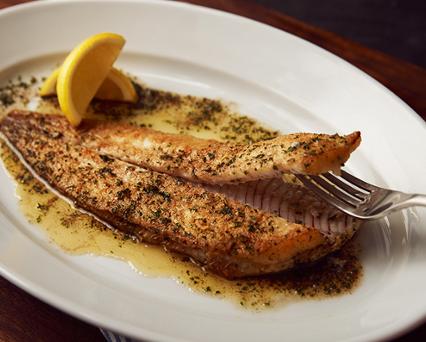 nor is the
boning of a filet like sole. But a good restaurant
has waiters who know how to do it with quick
dispatch so as to maintain the temperature. If a
lobster is ordered with its shell cracked, or the
meat extracted, that should be done quickly in the
kitchen. Waiters who try this maneuver at the table
take far too long and you end up with cold lobster.
Best thing to do is to ask for the claws to be
cracked in the kitchen, then do the rest yourself.
nor is the
boning of a filet like sole. But a good restaurant
has waiters who know how to do it with quick
dispatch so as to maintain the temperature. If a
lobster is ordered with its shell cracked, or the
meat extracted, that should be done quickly in the
kitchen. Waiters who try this maneuver at the table
take far too long and you end up with cold lobster.
Best thing to do is to ask for the claws to be
cracked in the kitchen, then do the rest yourself. 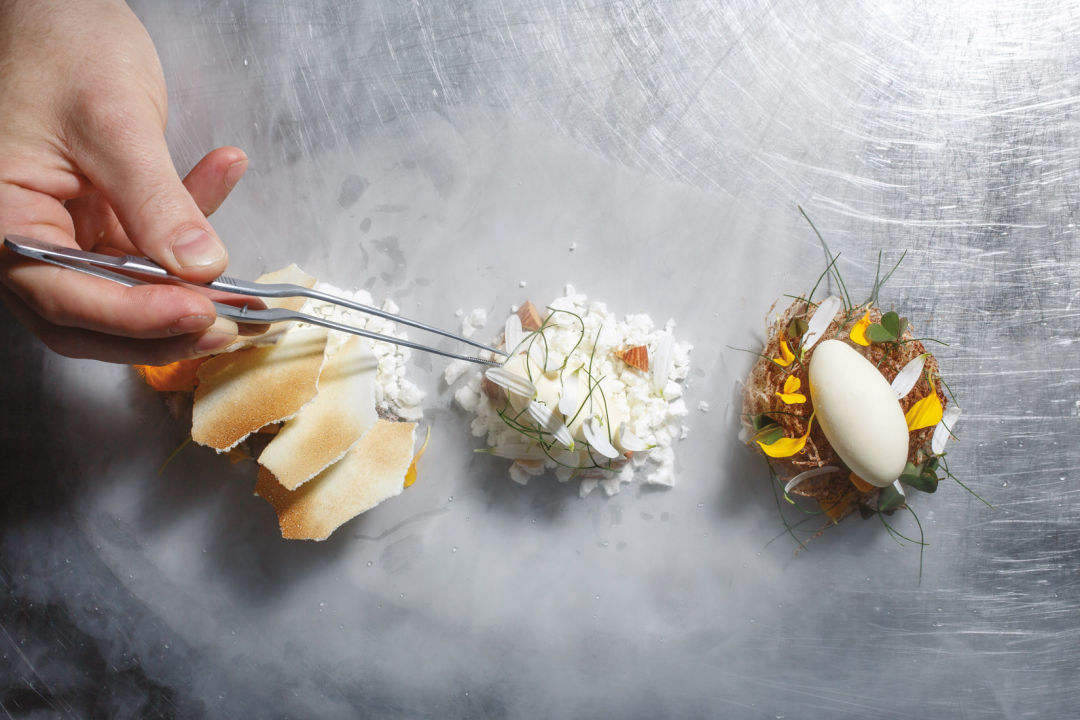
• Decoration on the plate and garnishes—Extravagance on plates went out a century ago and only came back under the assault of the modernist chefs who believe their best friend in the kitchen is a pair of tweezers with which they spend five minutes gussying up a dish. Anything that is not to be eaten should be left off the plate.
• Soup and Cheese—Granted, not that many people order
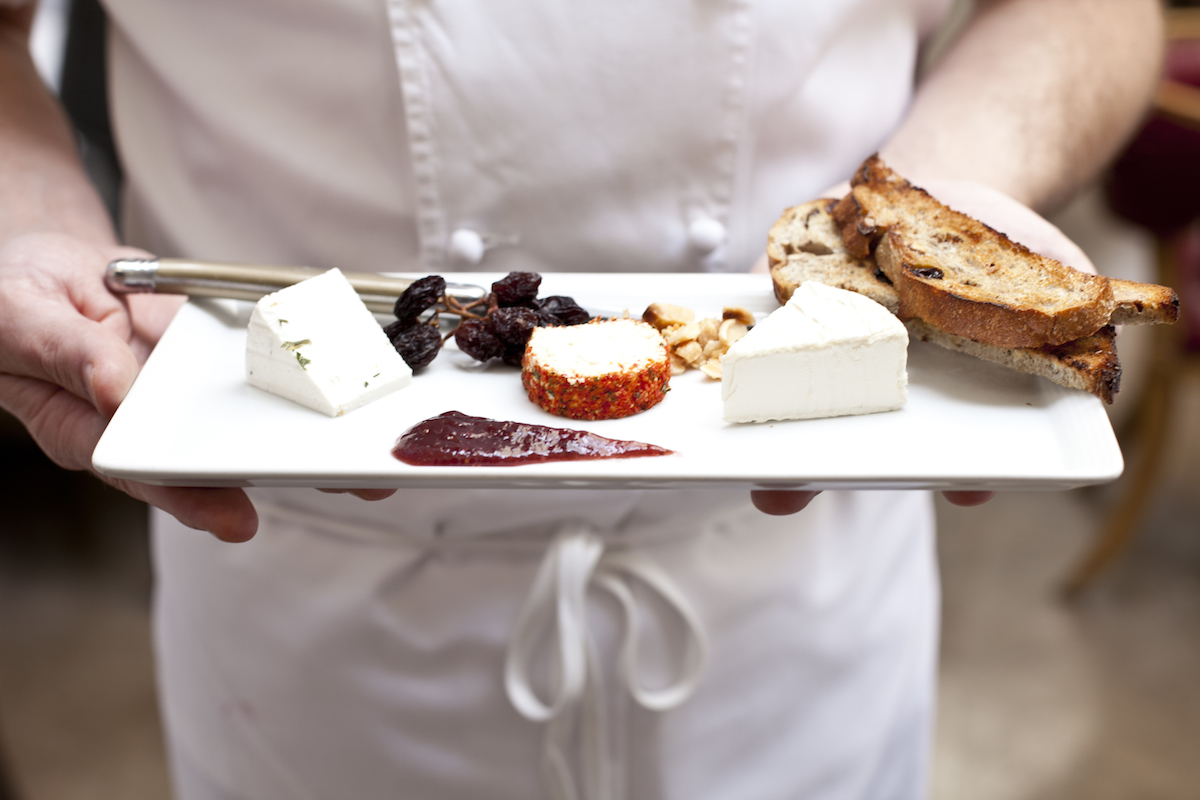 either soup or
cheese these days, but a perfect restaurant
(exempting, of course, most Asian restaurants)
should offer both, preferably as exemplary of the
region featured on the menu, like Venice or
Marseilles.
either soup or
cheese these days, but a perfect restaurant
(exempting, of course, most Asian restaurants)
should offer both, preferably as exemplary of the
region featured on the menu, like Venice or
Marseilles.• A simple menu—Almost always less is more on a menu, unless it’s at Cheesecake Factory. Indeed, a lengthy menu confuses and confounds guests, especially if the captain or waiter insists on describing every dish already described on the menu. And who cares what a waiter’s “favorite” is? No one really wants to have to choose from a menu with 16 appetizers, six salads, 12 pastas, ten meat dishes and ten seafood options. A carefully crafted menu focuses on what the chef does best and what he believes will showcase his real talents.
So, where have I had perfect dinners and can pretty much guarantee you will, too?
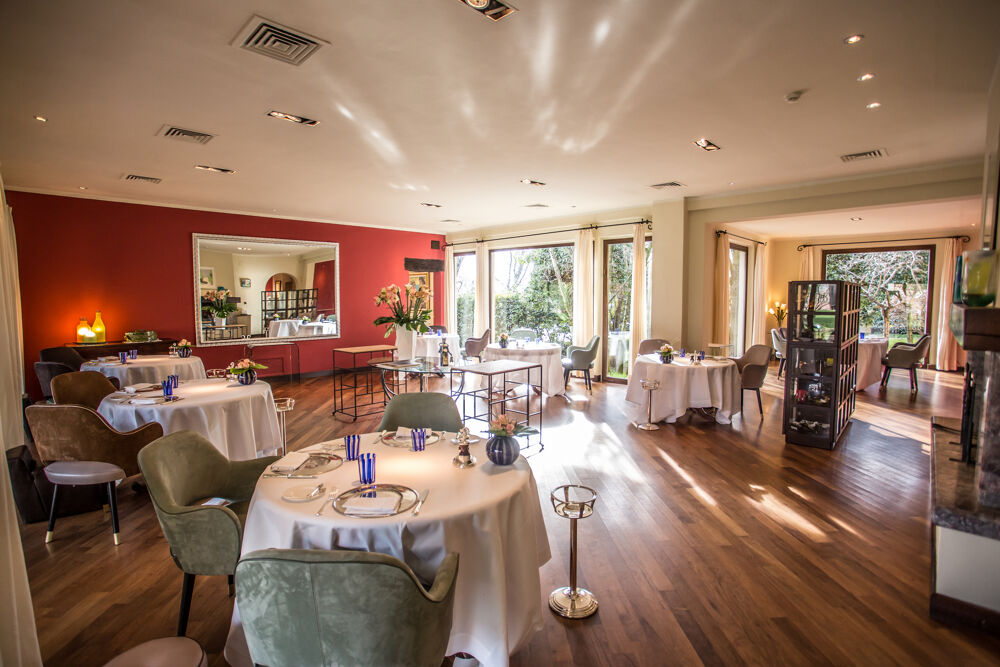
Dal Pescatore, Canneto sull’Oglio, Italy.
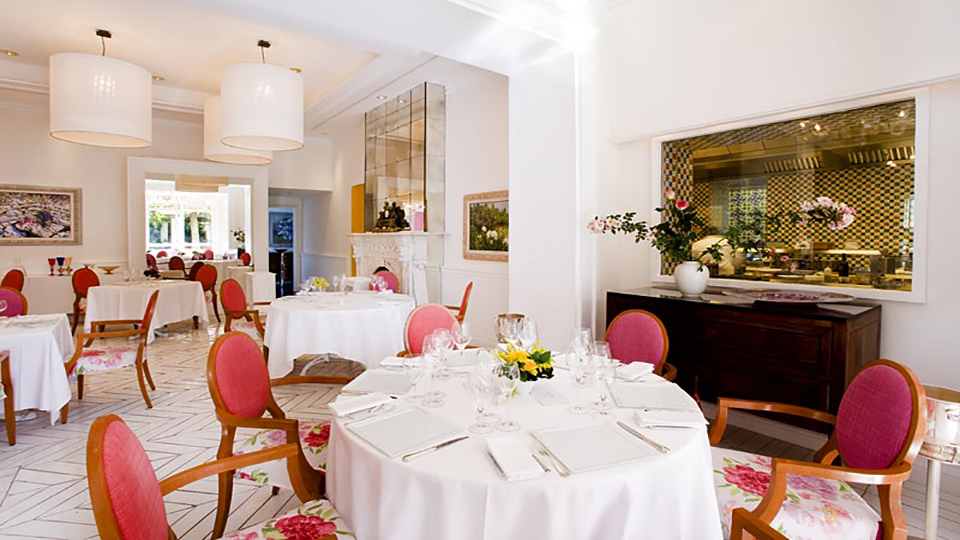
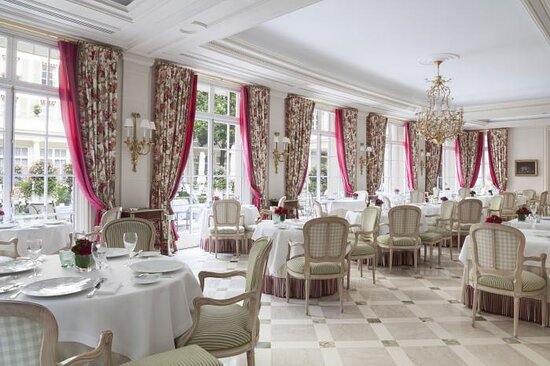
Epicure, Paris.

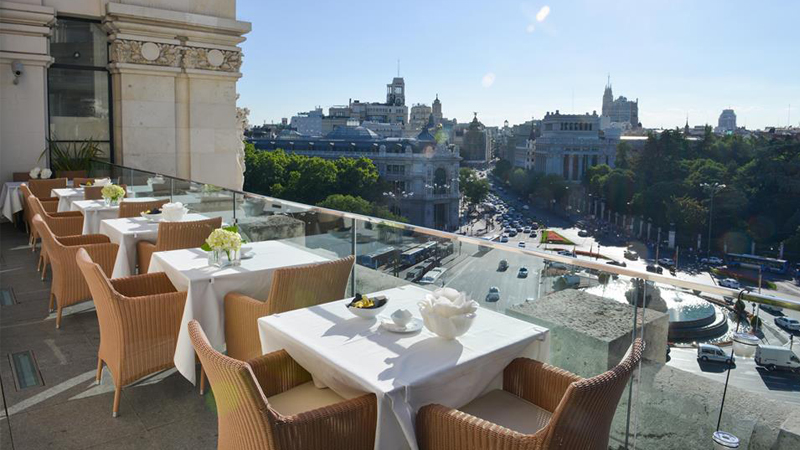
Restaurante Palacio Cibeles, Madrid
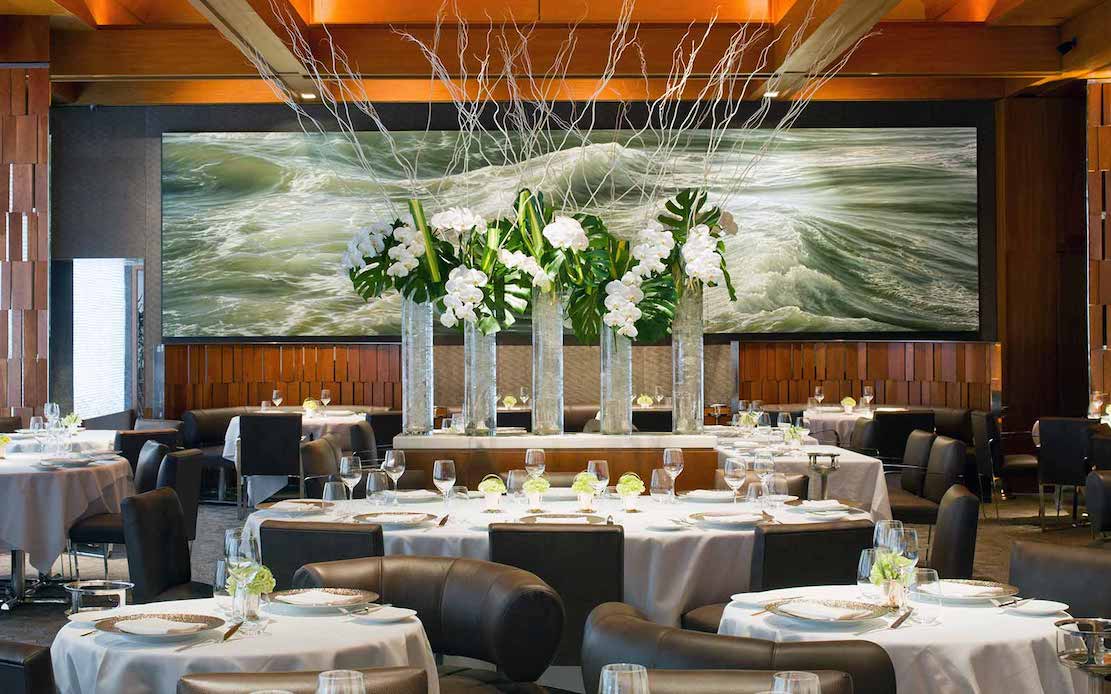
Le Bernardin, New York, NY.

Il Gattopardo, New York, NY.
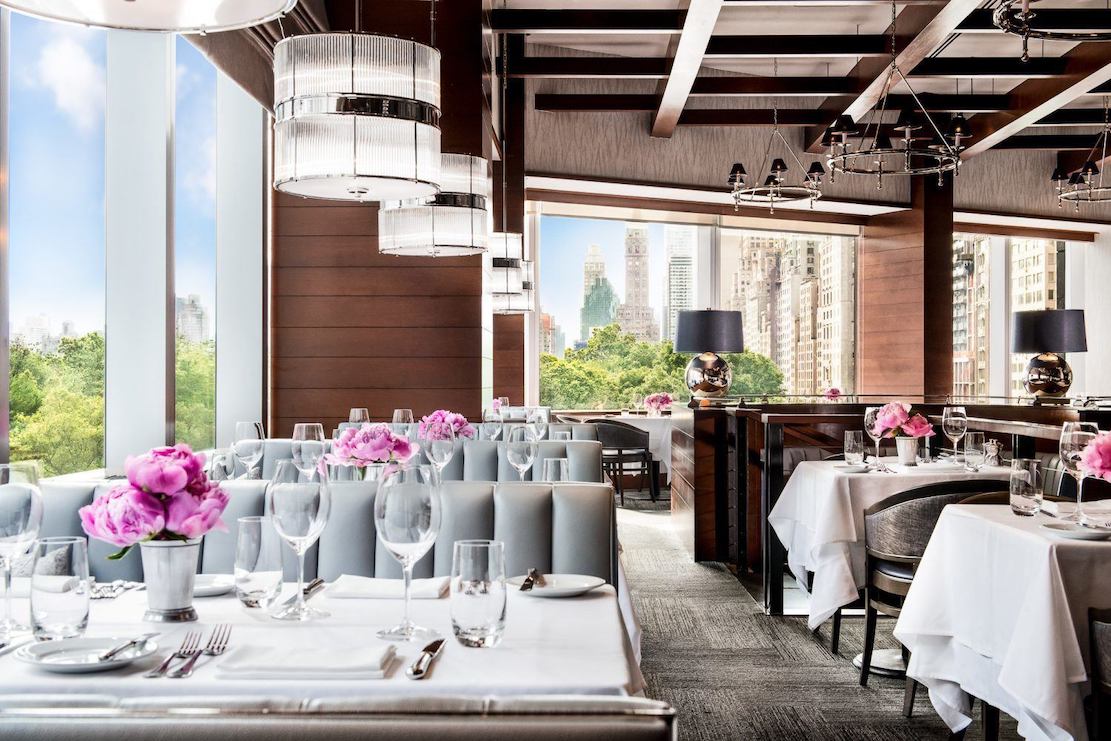
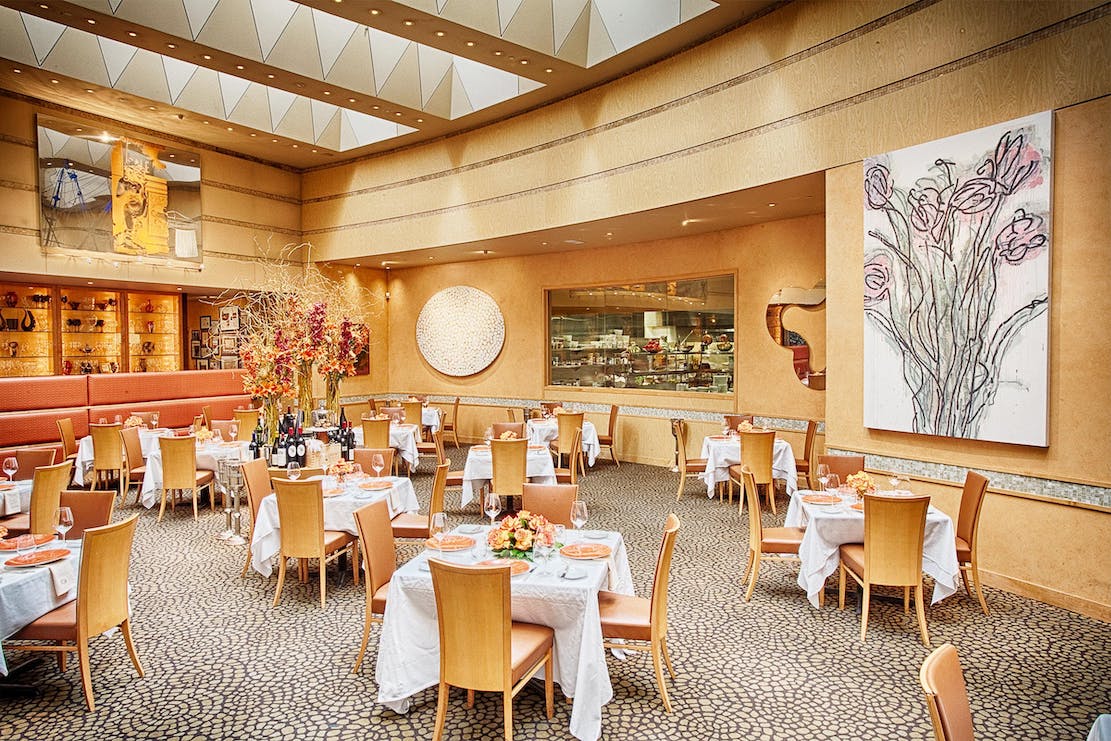
Tony’s, Houston, TX.
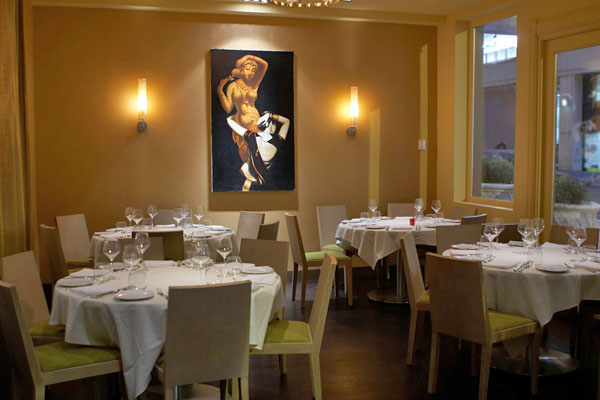
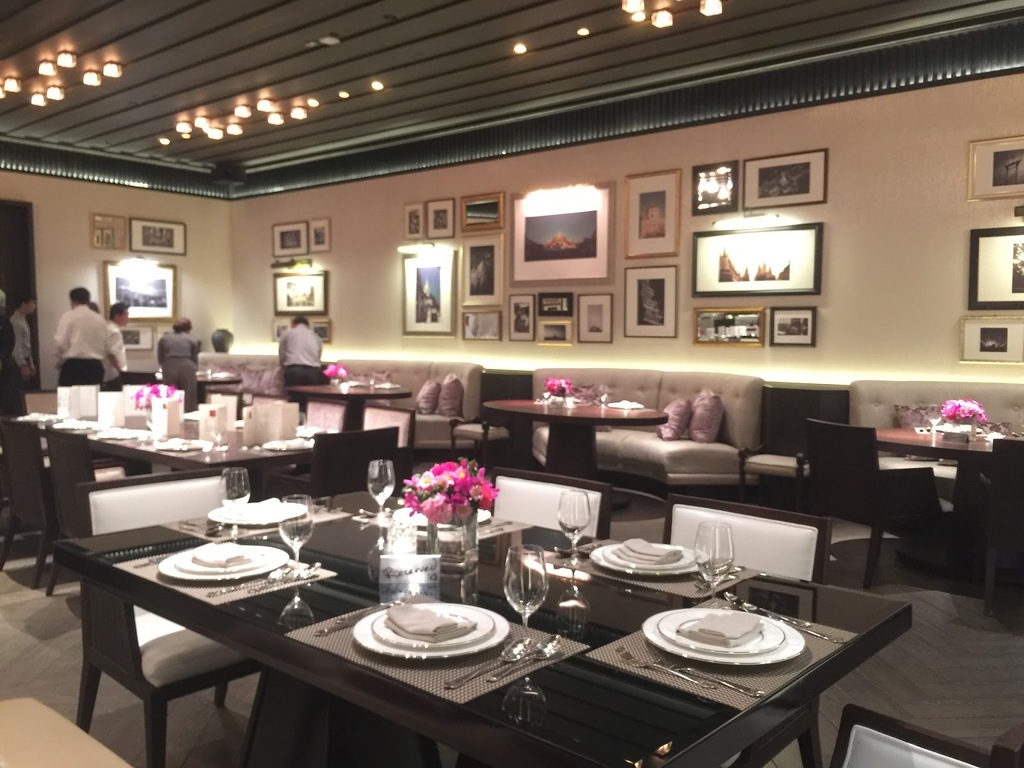
Saneh Jaan, Bangkok.
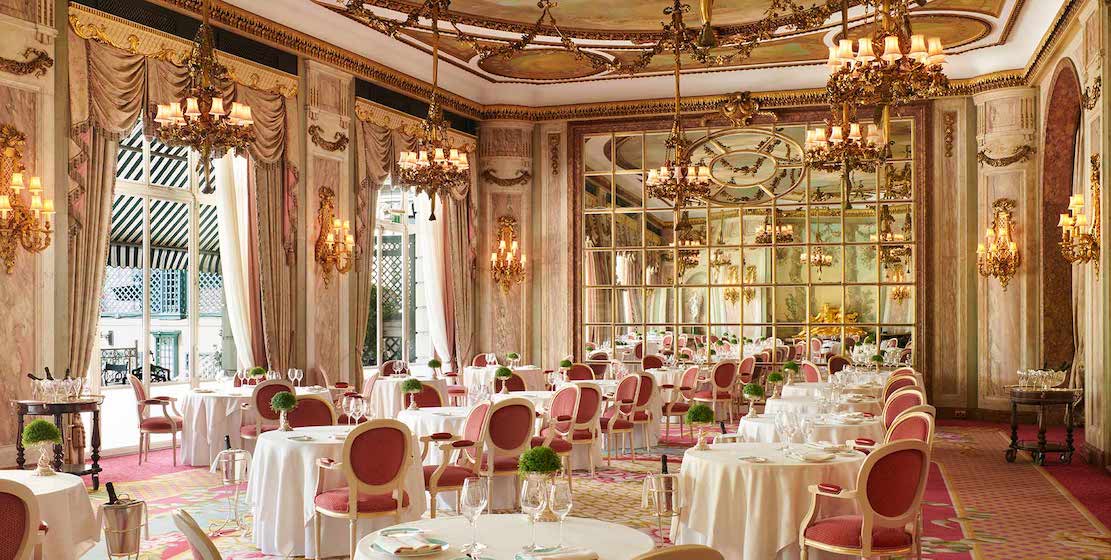
❖❖❖
VICTOR’S CAFÉ
236
West 52nd Street
212-586-7714

By John Mariani
Before Victor’s Café opened in 1963,
Cuban cooks worked in restaurants that sold
themselves as Spanish while lending a good deal
more spice and seasoning to the food. Victor del
Corral and his wife, Eloina Ruiz de Ugarrio (left), 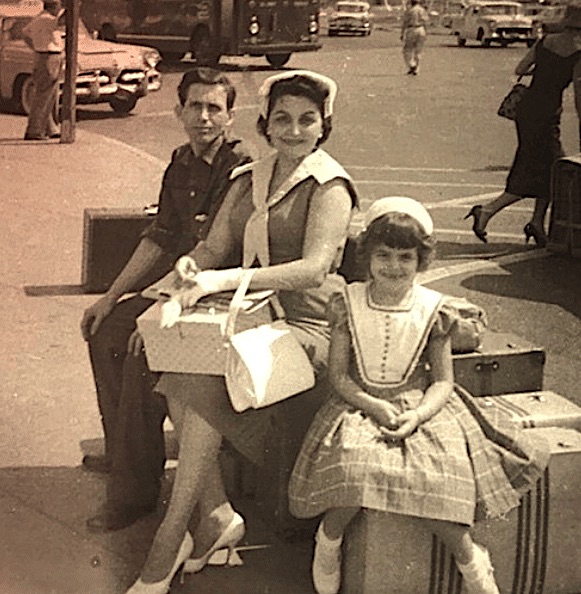 emigrated
from Havana and opened his namesake restaurant
on the Upper West Side, then moved to the
Theater District as of 1980. The move brought
waves of theatergoers and celebrities to
Victor’s over the past five decades, and now,
after a closure due to Covid, the place has a
brand new sheen and décor that makes it one of
the most convivial and colorful spots in New
York.
emigrated
from Havana and opened his namesake restaurant
on the Upper West Side, then moved to the
Theater District as of 1980. The move brought
waves of theatergoers and celebrities to
Victor’s over the past five decades, and now,
after a closure due to Covid, the place has a
brand new sheen and décor that makes it one of
the most convivial and colorful spots in New
York.
There are three dining rooms of various
sizes, each individually decorated with Cuban and
modern art, excellent lighting, and, somehow, a
moderate decibel level despite a highly convivial
crowd. You may also dine outside on the enclosed 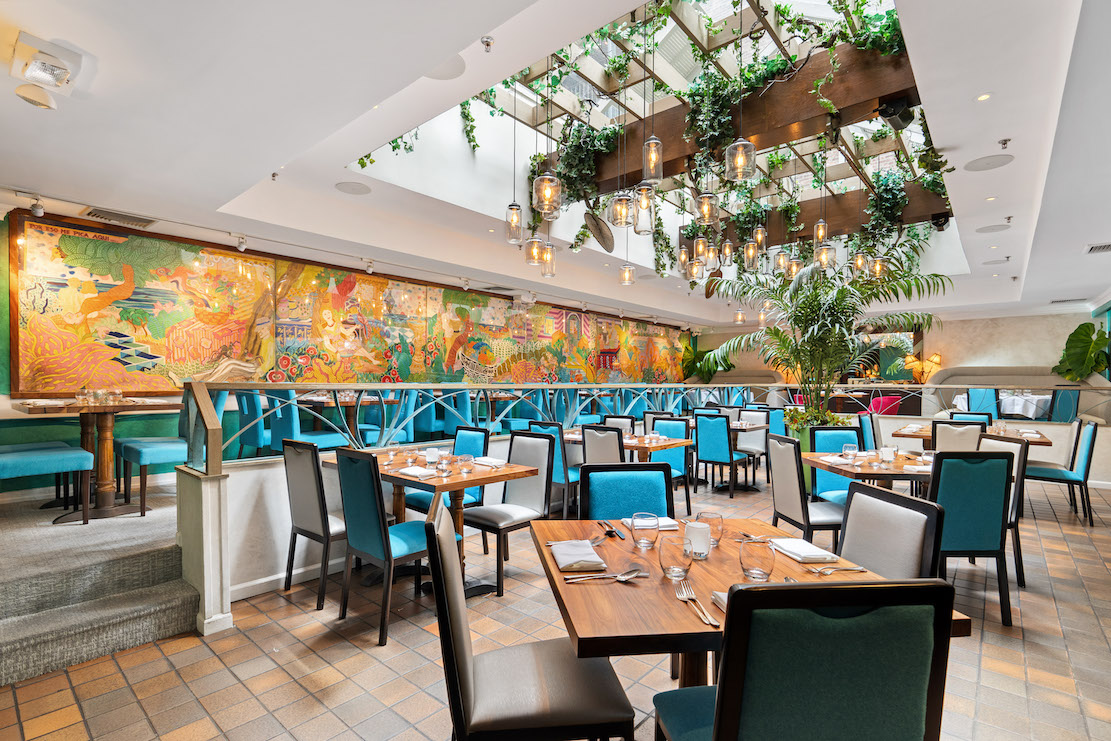 patio.
There is also a snug Cuba Lounge up front, with
live music and a portrait of boxer Roberto Durán,
who in 1980 reportedly ate a gargantuan meal at
Victor’s before going into the ring against Sugar
Ray Leonard and giving up in Round Eight, saying,
“No mas!”
patio.
There is also a snug Cuba Lounge up front, with
live music and a portrait of boxer Roberto Durán,
who in 1980 reportedly ate a gargantuan meal at
Victor’s before going into the ring against Sugar
Ray Leonard and giving up in Round Eight, saying,
“No mas!”
 Victor’s
daughter, Sonia Zaldivar, and granddaughter,
Monica Zaldivar (left) now run the
restaurant, along with the ebullient general
manager Francine Powell. The waitstaff could not
be more cordial and are very helpful in choosing
your dishes and wines. There are also some
terrific cocktails that include a first-rate
daiquiri and a range of mojitos.
Victor’s
daughter, Sonia Zaldivar, and granddaughter,
Monica Zaldivar (left) now run the
restaurant, along with the ebullient general
manager Francine Powell. The waitstaff could not
be more cordial and are very helpful in choosing
your dishes and wines. There are also some
terrific cocktails that include a first-rate
daiquiri and a range of mojitos.
As Guillermo Pernod and Lourdes Castro have
written in Cuba
Cooks (2018), Cuban cuisine is an amalgam
of influences that include native food, Spanish,
African, French and Chinese—this last owing to the
19th century immigration of 100,000 Chinese to
work the island’s sugar farms and docks. This
so-called comidas
criollas evolved over centuries, with both
indigenous and imported foods providing variety,
all represented on Victor’s well-structured menu.
There are more than a dozen appetizers at
Victor’s, and you can get a good sampling of
several of them by ordering the “1492 Aperitivo
Cubano” for two ($32). Or you can order individual
apps à la carte, such as a brisk ceviche of
Florida red snapper (below) with a citrus
marinade, red onion, mango and avocado ($17); a
“Havana guac” of avocado, tomato, cilantro,
onions, lime, tropical 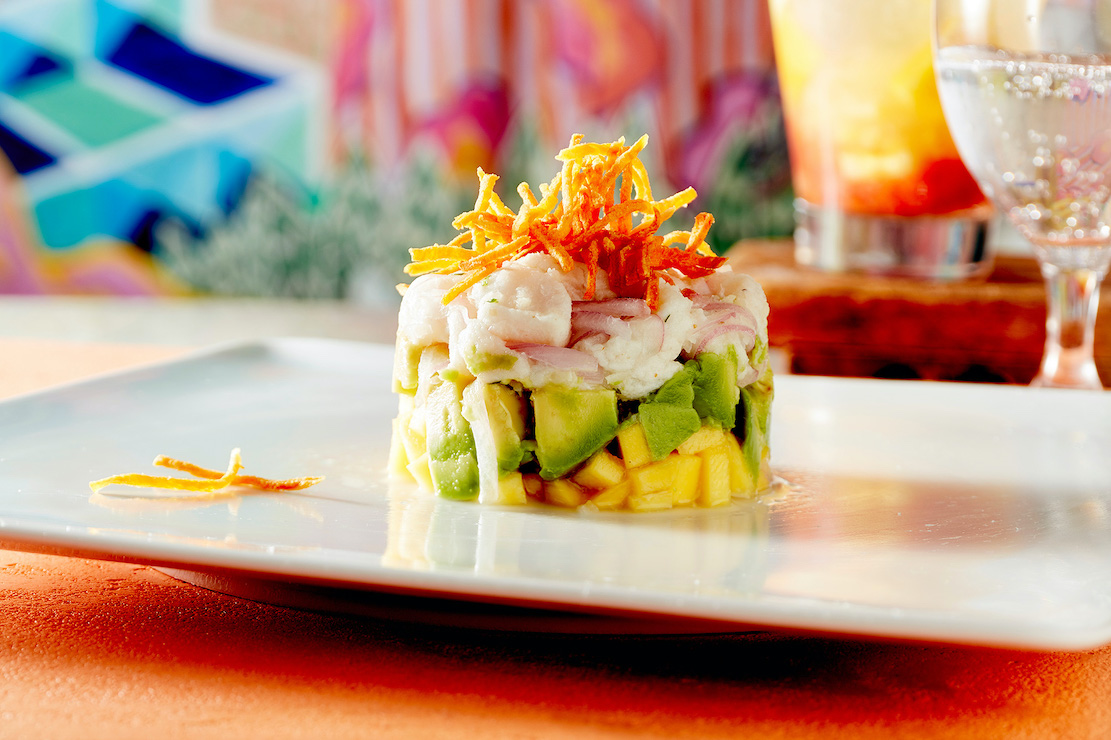 cheese and
tropical root chips ($13); excellent Cuban quesadillas
with Creole shrimp and manchego cheese ($13);
handmade sweet plantain croquettes called bartolitos
stuffed with roast pork, black bean purée and
goat’s cheese ($13); plump ham croquettes with
tomato-cachuca
pepper sauce ($10); puff pastry empanadas of
succulently braised chicken, mango and a
mango-habanero sauce ($10); fried plantains topped
with morsels of fresh pork
($11); and Cuban style beef with peppery chorizo
and pork sliders with matchstick fries ($14).
cheese and
tropical root chips ($13); excellent Cuban quesadillas
with Creole shrimp and manchego cheese ($13);
handmade sweet plantain croquettes called bartolitos
stuffed with roast pork, black bean purée and
goat’s cheese ($13); plump ham croquettes with
tomato-cachuca
pepper sauce ($10); puff pastry empanadas of
succulently braised chicken, mango and a
mango-habanero sauce ($10); fried plantains topped
with morsels of fresh pork
($11); and Cuban style beef with peppery chorizo
and pork sliders with matchstick fries ($14). 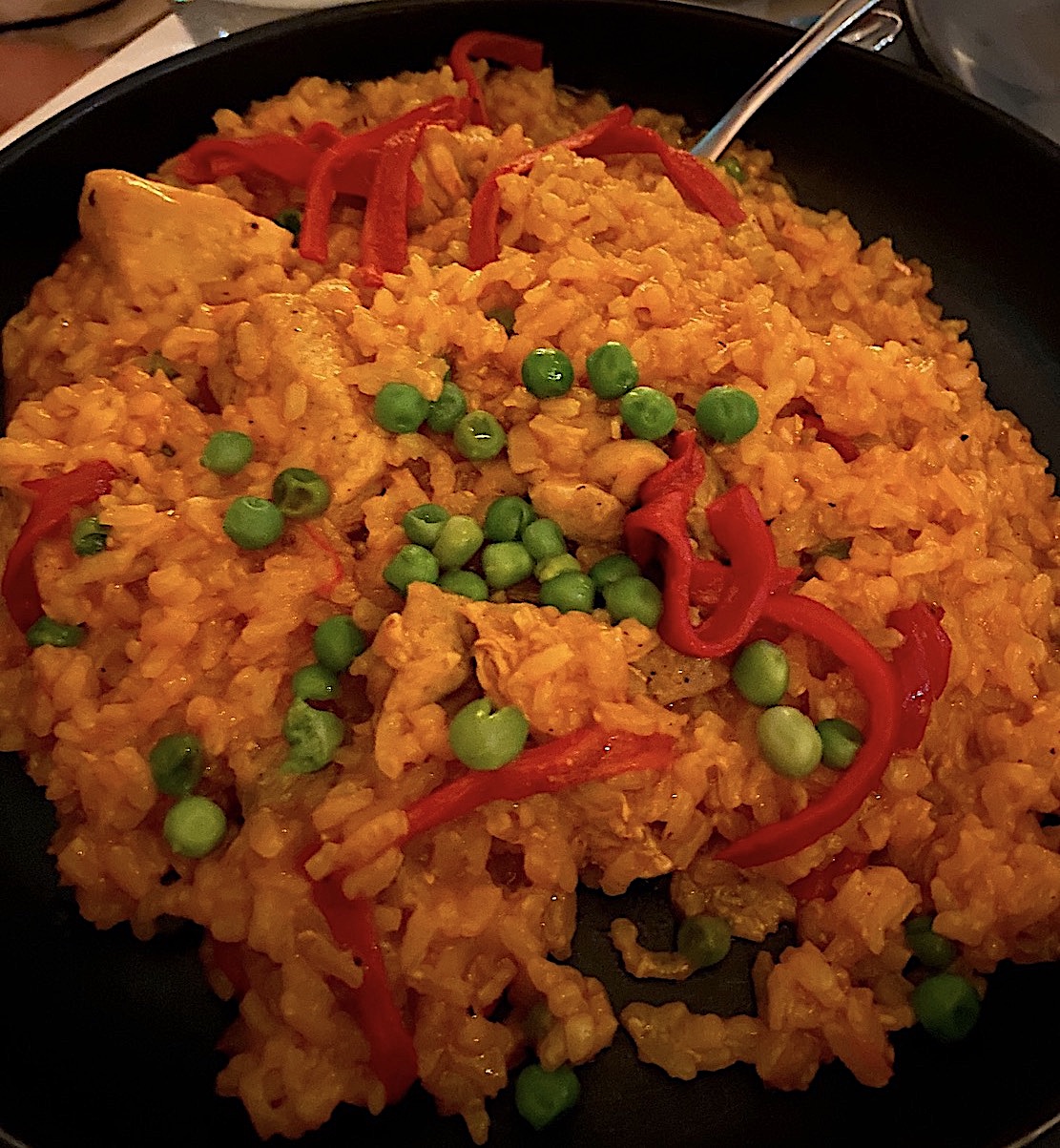 Every
one of them has its own distinct flavors,
textures and savoriness.
Every
one of them has its own distinct flavors,
textures and savoriness.
If you have
found Cuban food working-man heavy in the past, be
aware that Victor’s Café uses no lard in the
cooking, substituting lighter olive oil. Thus, the
specialty of ropa vieja
($32) is slowly braised, shredded skirt steak in
an aromatic, rich but not heavy garlic, tomato,
onion and pepper sauce, while pan-fried shredded vaca frita
is skirt steak with red onions and a tangy-sweet
Seville orange and garlicky mojo. One
of the best dishes is the lechon asado
of 24-hour marinated roast pig cooked
in Cuban-style mojo with
plenty of garlic, yucca and moros black
beans ($32). It arrives with crackling crisp skin
and buttery flesh beneath. All main courses come
with rice and black beans, but I also urge you to
try one of the rice dishes like the arroz con
pollo à la chorrera ($26) in a casserole (left),
which easily serves four as a side dish or two as
a main.
There are five seafood dishes, though oddly
two  of
them are salmon, a fish that swims in waters a
long way from Cuba. Much better are the Florida
red snapper fillet with green plantain crust, sofrito
and the starchy mash called fufu ($37)
or
you can have it grilled with corn, cherry
tomatoes, scallions and cilantro ($37). There is
also enchiladas of shrimp and a spicy Creole sauce
with boniato
purée and boniato
crisps ($29).
of
them are salmon, a fish that swims in waters a
long way from Cuba. Much better are the Florida
red snapper fillet with green plantain crust, sofrito
and the starchy mash called fufu ($37)
or
you can have it grilled with corn, cherry
tomatoes, scallions and cilantro ($37). There is
also enchiladas of shrimp and a spicy Creole sauce
with boniato
purée and boniato
crisps ($29).
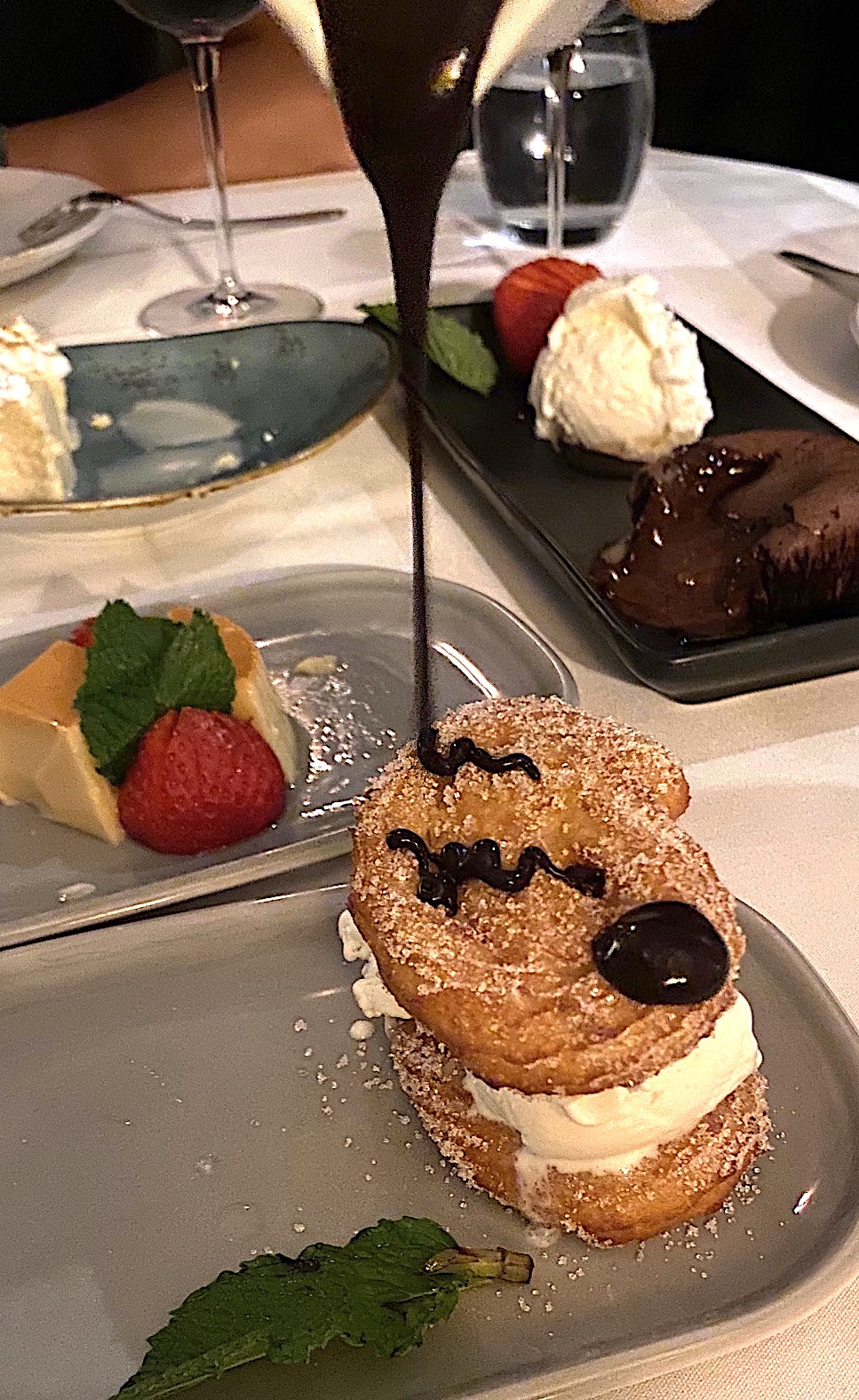 At
least share a dessert ($8-$11) like the Cuban flan
with caramel sauce; the warm guava cobbler; the
cinnamon-scented rice pudding, the wonderfully
rich and sweet tres leches
sponge cake; and the hot, crunchy churros
with hot chocolate sauce (left) are
irresistible.
At
least share a dessert ($8-$11) like the Cuban flan
with caramel sauce; the warm guava cobbler; the
cinnamon-scented rice pudding, the wonderfully
rich and sweet tres leches
sponge cake; and the hot, crunchy churros
with hot chocolate sauce (left) are
irresistible.
Victor’s Café is, as noted, smack in the
theater district and, while they do not have a
specific pre-theater menu, the place is always
hopping by 5:30, and it’s a good place to come for
a drink after theater at that lounge.
I am so glad to
see Victors Café back open and definitely in the
swing of things. It may be a radical departure
from the kind of restaurants you find in Havana
these days (which Cubans cannot eat at), but there
is definitely a New York swagger to Victor’s Café
that makes it all the more sexy and appealing.
Victor’s Café is open for dinner
Wed.-Sat.
CAPONE’S
GOLD
 The two of them met the next day at
the New York Public Library, where David had
been looking into table settings and flatware
patterns of the 1930s, as well as who might
have made personalized sets in New York,
Chicago or Miami. The
reference librarian gave David a look to
suggest, “You don’t look the type.”
The two of them met the next day at
the New York Public Library, where David had
been looking into table settings and flatware
patterns of the 1930s, as well as who might
have made personalized sets in New York,
Chicago or Miami. The
reference librarian gave David a look to
suggest, “You don’t look the type.”
He had also paid visits to various
precious metal exchanges in Manhattan, some of
whose owners had worked with the police on
stolen goods.
“Fancy
meeting you here, in a library,” said Katie.
“Don’t worry. I’ve
got my brass knuckles and Taser with me just in
case.”
“So, anything new?”
“I’ve been looking into table settings.”
Katie feigned blushing, crossed her hands
on her chest, and said, “Oh, David, this is so
sudden!”
“Yeah, well with what I make, stainless
steel flatware is more likely. So, anyway, I
found that solid gold knives, forks and spoons
would have been outrageously expensive, and, in
the 1930s, the gold would have been very
difficult to obtain.”
He read from his notes: Most
gold flatware is just gold plated, with under
layers of silver or copper. Even
so-called “gold-filled” jewelry is a layer, and
by law has to be at least five percent of the
item’s total weight. But in
the 1920s and 1930s, some gold-filled items,
called “rolled gold plate” contained 12.5
percent 14 karat gold. Anything
solid gold would be unique in any era.
“That setting Theresa Scali had would
have been, well, worth its weight in gold,” he
said.
“And she said there were maybe twenty
settings total,” Katie added.
“That still wouldn’t add up to more than
a few melted down ingots,” said David. “I figure
that Capone just had the gold settings made for
his own pleasure before he went to prison. And
when he died, and the feds tried to confiscate
his holdings, his wife or mother gave the
settings to various family members as a gift. Telling
the feds that their gold was melted down to make
settings for his dinner table was not likely to
sit well with the feds, who would then indict
him for merely owning the stuff and use it as
evidence he was behind the heist.”
“All right,” said Katie, “so we eliminate
a few ingots of gold. Where’s
the rest?”
“I was just going to ask you if it might
be in Germany.”
Katie took out her notes from her meeting
with Professor Mundt and made a very detailed
report.
“So, it’s possible that Capone made
friends with Adolph Hitler and had the gold
shipped to Germany?” asked David.
“Well, if he did he couldn’t touch it
during the war. And by then, from what Professor
Mundt said, most of the loot was either stolen
by the Nazi higher-ups, deposited in
Switzerland, recovered by the Allies and Russia,
or is still sitting in tunnels throughout
eastern Europe.”
“So, shy of our digging and spelunking
our way through the mountains of Bavaria,
Poland, and the rest of eastern Europe,” said
David, “that info leads nowhere. Besides, if the
Nazis smelted and changed the stamp on the gold
bars, you couldn’t tell if it came from the
Federal Reserve anyway.”
“True,” said Katie, “but if we could at
least find out that Capone did somehow ship the
gold to Germany, that’s not only part of my
story but may be enough to get the feds to hand
over the reward.”
David shook his head and said, “That I
doubt. The
reward is for information leading to the
‘recovery’ of the gold, not just saying where it
might have gone.”
“I guess you’re right, but it’s still
part of the story and, if we could find out how
much—maybe all—of it went to Germany, it would
be a coup on our part. And,
if it did not all go to Germany, it’s still out
there, and we can eliminate one whole country in
our search.”
“I feel better already,” said David. “So
now I think we’re back to Capone’s boats. His
bigger yachts could sail the Atlantic, or,
what’s easier, they could rendezvous with a
German ship beyond the 12-mile limit. A
rumrunner, if fitted to carry successive, light
shipments of the gold might be even a better
idea in case they had to make a run for it.”
“Any idea how’d we’d go about finding
evidence of that?”
“There must be records of ship
itineraries from before the war. I
think we should call on Edward Prus and find
out.”
David and Katie walked the two blocks
from the library to the New York Yacht Club and
asked to see Edward Prus. This
time the wait was short and Prus seemed happy to
see the couple, who asked where there might be
maritime records on sailings as far back as the
mid-1930s.
“Hmm, the only archive I can think would
have such material would be the Naval Institute
in Annapolis,” said Prus. “I can
give you an introduction to some people down
there, if you like, and they can gather what you
might be looking for if you give them a day or
two.”
Katie and David thanked Prus for the
offer and left to plan a quick trip on Amtrak
down to Annapolis.
*
*
*
 The
U.S. Naval Institute is located just across
Peters Cove from the U.S. Naval Academy (below),
and since Katie and David arrived an hour early
for their appointment at the Institute, they
walked like tourists through the red brick
streets of Annapolis, visited St. Mary’s Church,
and meandered through the Naval Academy, where
cadets in various uniforms walked briskly,
without ever setting foot on the campus grass.
The
U.S. Naval Institute is located just across
Peters Cove from the U.S. Naval Academy (below),
and since Katie and David arrived an hour early
for their appointment at the Institute, they
walked like tourists through the red brick
streets of Annapolis, visited St. Mary’s Church,
and meandered through the Naval Academy, where
cadets in various uniforms walked briskly,
without ever setting foot on the campus grass.
At
two o’clock, Katie and David entered the
Institute and met Lieutenant William Gaudet, who
appeared to be in his mid-forties.
“I hear you know Ed Prus,” said Gaudet.
“Very knowledgeable man, at least about the
yachting world.”
“He was very helpful,” said Katie, “but
he said you’d be the man to help us with
maritime records from the 1930s.” She then
explained the relevance to Al Capone and the
connection to Nazi Germany.
“Interesting topic,” said Gaudet. “Before
the war there was a lot of activity in the
Caribbean and the Atlantic between Germany and
other countries, especially Brazil and
Argentina.
We have a good deal of archival material
on that, and we even have a lot on the rumrunner
boats, because so many of them were used by the
Navy during the war for sub chasing and other
patrol activities.
They were very fast boats, you know.”
Gaudet led them to a library desk and
said he’d be back with materials in a few
moments. Katie
took out her pocket recorder. When he returned
Gaudet had a very large map of the Atlantic,
labeled 1938.
“If I may begin with a little background
of what was going on back then,” said Gaudet,
spreading out the map of the Atlantic, lined
with myriad shipping lanes of the day. “If Al
Capone, or anybody, wanted to ship something to
Germany in the mid-1930s, it would have come
under scrutiny by port authorities on this side
because the signs that Hitler was not to be
trusted had already shown themselves.”
Gaudet went on to
explain that Hitler’s need for gold early on was
driven by his desire to build a strong navy for
Germany, whose size and tonnage had been very,
very restricted by the League of Nations. The
priority, therefore, was to rebuild the army and
air force, because ship building on a naval
scale takes enormous resources of steel,
shipyards, and workers skilled enough to handle
the new technologies of the time. So,
although Hitler later flouted the restrictions
on German naval power, the construction of
U-boats was cheaper and easier to hide than
battleships. As you know, once the war started,
U-boats became the most powerful weapon in
Hitler’s arsenal until the British cracked the
Nazi codes and could track the U-boats on all
their missions.
“And the U-boats of the early 1930s were
good enough to cross the Atlantic?” asked David.
“Oh, yes. Remember, the Germans for all
intents and purposes invented the submarine
before World War I, so their expertise was
unparalleled by the 1930s. And they were
constantly making improvements to them.”
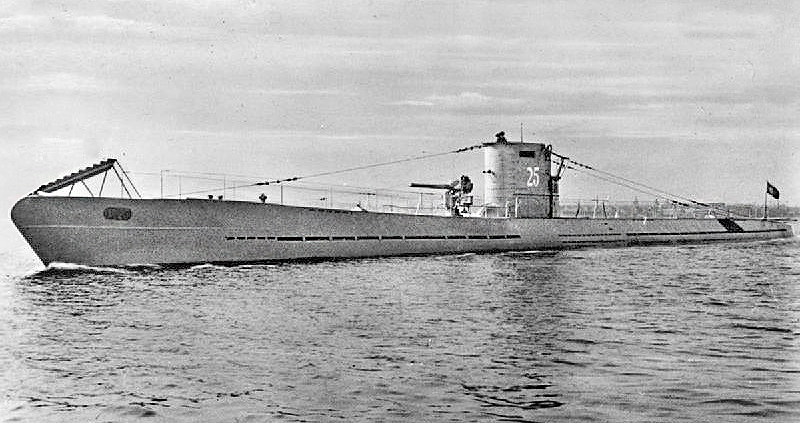 “So, you’re saying that the Germans were
more likely to use U-boats for these clandestine
rendezvous with ships on this side of the
Atlantic?”
“So, you’re saying that the Germans were
more likely to use U-boats for these clandestine
rendezvous with ships on this side of the
Atlantic?”
“It’s highly likely,” said Gaudet. “As I
mentioned, boats flying the German flag would
have come under greater scrutiny sailing out of
American or British Commonwealth ports. But
U-boats could sneak up to the 12-mile limit or
wait a few hundred miles away in the Atlantic
and make transfers without being noticed.”
“And do you have any information that
American gangsters were in league with the
Germans for such transfers?” asked Katie.
“Oh, absolutely,” said
Gaudet. “You may know that Henry Ford (below)
himself was an ardent anti-Semite, and in 1938
he received the Grand Cross of the German Eagle
from Adolph Hitler, who admired Ford’s assembly
line techniques for the Model T as adaptable to
producing the Volkswagen. Hitler
also saw Ford as a comrade-in-arms against the
Jews. He
even mentioned Ford as a hero in Mein Kampf.”
“And you’re saying Ford shipped illegal
goods and technology to Germany via U-boats?” 
“He didn’t have to. There was nothing
illegal about Ford trading with Germany before
the war. He
even sent experts to help the Germans set up
their assembly lines. In fact, before 1939, Ford
subsidiaries controlled 70 percent of production
in Germany.
Of course, once the war started, Ford’s
participation ceased.”
“All right,” said David, “so, if trade
with Germany was perfectly legal, what would not
have been legal to ship to Germany?” (David
already knew the answer.)
Gaudet turned his palms up and said,
“Why, gold, of course. And
from what you tell me, Capone was the only
American who had a significant cache of gold to
hide. What
better place to store it than Germany or
Switzerland?”
“And a U-boat could lug that much gold
across the Atlantic?”
“Well, you’ve given me no idea of the
amount of gold there was, but it could have been
accomplished over several trips.”
Katie asked, “Is there any chance you
have records of these clandestine trips. I
mean, if they were made in secret they wouldn’t
have been recorded.”
“True,” answered Gaudet, “but,
fortunately, we do have records of U-boat travel
before 1939 that were gleaned from German
archives after the war. The
Nazis certainly knew where all their U-boats
were going.”
“Well, we’re looking at a period probably
right after 1934, maybe early ’35,” said David. “I
don’t suppose there’s any chance you’d have the
logs of rumrunners of the period.”
“Actually, we do have some. They came
with the confiscated boats. Listen, if you
haven't had lunch, go ahead and I’ll see what I
can find meanwhile?”
Katie and David went off to
lunch—Maryland crab cakes and cold beer—and
talked a blue streak about what they’d just
learned from Gaudet.
“I think this is the missing link we’ve
been looking for,” said Katie. “It’s
amazing that Gaudet has these kind of archives.”
“Well,
don’t get too excited,” said David. “He may not
have the ones we need to make the connection. I
can’t imagine they have anything like complete
files.”
© John Mariani, 2015
❖❖❖
SUSTAINABILITY NOW THE
RULE IN WINEMAKING
by John Mariani

It is difficult to understand how
farmers and fishermen so often put immediate
gains over long-term plans to keep their
industries going. Farmers deplete the minerals
in their farms’ soil and go for optimal volume
over taste, while fisherman collect every
lobster and all the tuna they can find, knowing
the supply is not unlimited. In the world of
viticulture, however, sustainability has become
far more the rule than the exception and
concerns over the myriad changes global warming
can cause in a vineyard, from water to insects,
are driving major investments to blunt their
oncoming force. Here are some international
wineries in the forefront of the battle.
 Villa Maria: This well-known,
innovative winery has launched a new
sustainability-focused wine range focused on
naturally farmed Pinot Noir and Sauvignon Blanc
under the EarthGarden
label. The wines are from naturally farmed Pinot
Noir and Sauvignon vineyards, free of synthetic
chemicals, and Villa Maria has invested heavily in
developing wildflower garden systems and
regenerative viticulture across many of their
owned vineyards.
Its Villa Maria EarthGarden Marlborough
Sauvignon Blanc 2020 ($20) is really an
evolution of NZ style, with far more complexity
than so many others in the past, with combined
citrus and flower aromas underpinned with acid.
Its Villa Maria EarthGarden Marlborough Pinot Noir
2019 ($24) is not as blockbuster powerful as
others are, which means more subtlety and
earthiness to be appreciated.
Villa Maria: This well-known,
innovative winery has launched a new
sustainability-focused wine range focused on
naturally farmed Pinot Noir and Sauvignon Blanc
under the EarthGarden
label. The wines are from naturally farmed Pinot
Noir and Sauvignon vineyards, free of synthetic
chemicals, and Villa Maria has invested heavily in
developing wildflower garden systems and
regenerative viticulture across many of their
owned vineyards.
Its Villa Maria EarthGarden Marlborough
Sauvignon Blanc 2020 ($20) is really an
evolution of NZ style, with far more complexity
than so many others in the past, with combined
citrus and flower aromas underpinned with acid.
Its Villa Maria EarthGarden Marlborough Pinot Noir
2019 ($24) is not as blockbuster powerful as
others are, which means more subtlety and
earthiness to be appreciated.
The Las
Brisas Vineyard in Napa
Carneros is perfect for cool-climate wines, with
daily fog lying on the terroir until noon. Its
2018 Riesling ($38) is rare among this California
varietal for its equilibrium of flavor, acid and
spiciness, closer to an Alsatian style. The
company’s mantra is that “In our vineyards,
cellars and offices, Carneros Wine Company |
Mahoney Vineyards focuses on stewardship of the
lands that provide for us. From the energy
efficient tractors and owl boxes in our vineyards,
to the solar arrays and recycle programs in our
offices, we try to minimize our carbon footprint
whenever and wherever we can. In fact, because we
are in the agriculture business, our goal is to
produce less CO2 than our vineyards offset.”
FEL vineyards
in Anderson Valley, California, uses every modern
technique to combat climate change, including
natural compost and organic fertilizer; cover
cropping; conversion to no tillage; mechanical
weed control; a riparian habitat for wildlife
corridors and aquatic habitats; deficit
irrigation; and integrated pest management. The
2020 FEL Anderson Valley Pinot Gris ($28) comes
from the Hein Vineyard, Anderson Valley’s
so-called "Deep
End,” whose nearness to the Pacific Ocean cools
things down and allows the grapes to develop
without getting overripe, so you have a Pinot Gris
with more body and pear flavors than the bland
examples that come from France and Italy.
Even Lambrusco is gaining
by careful tending of the vineyards in
Emilia-Romagna, with Venturini
Baldini’s Cadelvento organic Lambrusco
Spumante DOP ($21.99) brut rosato a
real step forward for a wine too often associated
with plonk like Reunite while still maintaining
the forward fruit of the indigenous grape. Its
dryness and sparkle also make it a good match for
shellfish, and, of course, by tradition with the
rich pasta dishes of the region. They also make a
Lambrusco Emilia IGP Semi Sec ($16.99) from 100%
Lambrusco Salamino that is quite aromatic and
ideal as an apéritif to drink with antipasti.
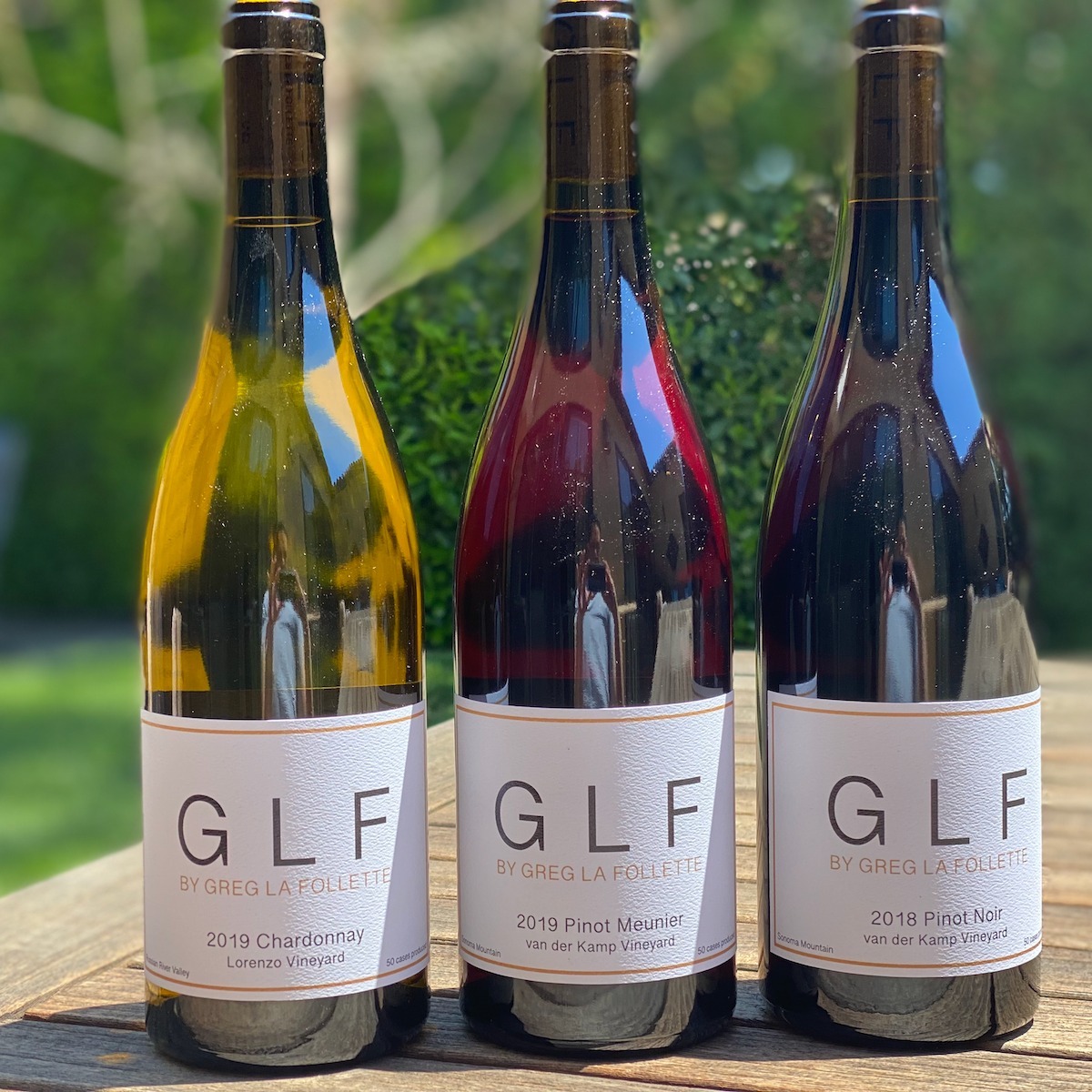 Renowned
Winemaker Greg La Follette has
launched what he calls an “Accessible Premium
Wine Brand” under the GLF
Wines label, the grapes picked from
Sonoma County and Russian River from select
vineyards, with prices beginning at $25. The
price is indeed accessible and, given La
Follette’s pedigree, the wine is exceptionally
well made, with plenty of complexity in its 2019
North Coast Pinot Noir ($25)
and 2019 North Coast Chardonnay ($25),
both made in moderately sized production. The
reason La Follette can buy such quality grapes
that usually go for a high price is because of
long-time relationships with growers.
Renowned
Winemaker Greg La Follette has
launched what he calls an “Accessible Premium
Wine Brand” under the GLF
Wines label, the grapes picked from
Sonoma County and Russian River from select
vineyards, with prices beginning at $25. The
price is indeed accessible and, given La
Follette’s pedigree, the wine is exceptionally
well made, with plenty of complexity in its 2019
North Coast Pinot Noir ($25)
and 2019 North Coast Chardonnay ($25),
both made in moderately sized production. The
reason La Follette can buy such quality grapes
that usually go for a high price is because of
long-time relationships with growers.
Marques de
Casa Concha Carménère 2019 ($24.99) is a
superb example of this under-appreciated varietal
from Chile, aged for 12 months in French oak
barrels, so you get good but softening tannins and
levels of fruit and acids that make it great for
roasts and casseroles. The Marques de Casa Concha name dates to 1718, when
King Philip V of Spain granted the noble title
of “Marques de Casa Concha” to Jose de Santiago
Concha y Salvatierra for his merits as governor
of Chile. Today it has been recognized by the
Hallbars Sustainability Report Awards as one of
the world’s best in the Food and Beverage
sector.
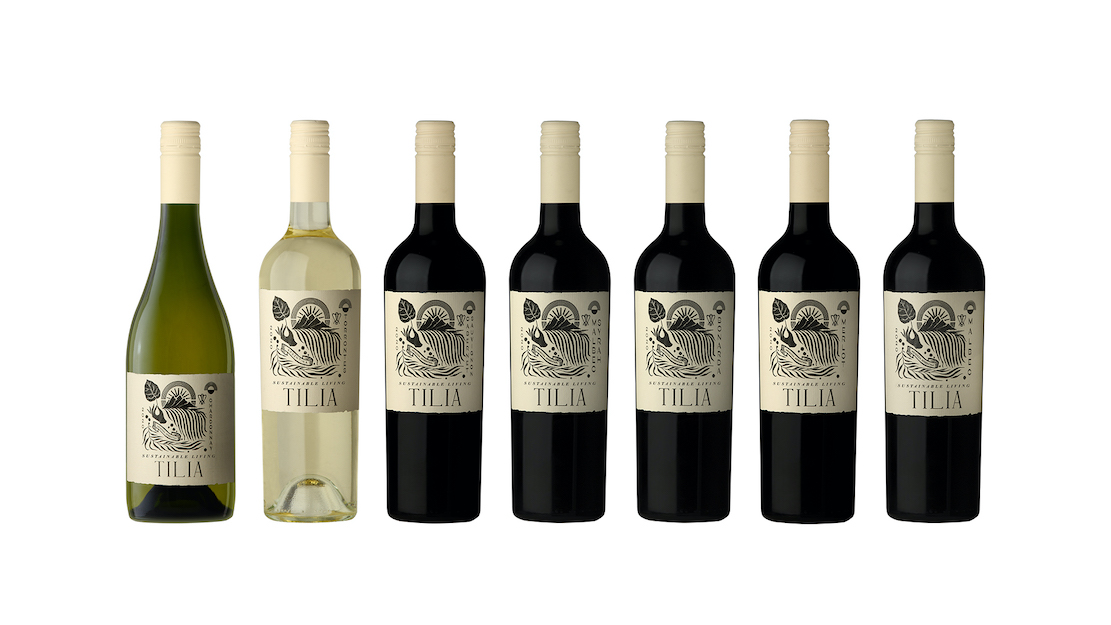 Tilia wines
of Argentina’s Mendoza Valley is “rooted in a deep
connection with the surrounding natural
environment and the stages of life in the
vineyard, interrupted without fail by the family
weekend gathering for asado,
our name for barbecue.” I like that statement
because it inextricably links wine to food and
vice versa. Tilia is also the first Argentine wine
to carry the Bodegas de Argentina Certified
Sustainable Seal on its label. Its vineyards lie
in both the Eastern and Southern regions with
elevations ranging from 1,500 to 3,000 feet above
sea level. Its well-priced Malbec ($11.99) and
Torrontes ($14) show how well such wines show
without a spike in price.
Tilia wines
of Argentina’s Mendoza Valley is “rooted in a deep
connection with the surrounding natural
environment and the stages of life in the
vineyard, interrupted without fail by the family
weekend gathering for asado,
our name for barbecue.” I like that statement
because it inextricably links wine to food and
vice versa. Tilia is also the first Argentine wine
to carry the Bodegas de Argentina Certified
Sustainable Seal on its label. Its vineyards lie
in both the Eastern and Southern regions with
elevations ranging from 1,500 to 3,000 feet above
sea level. Its well-priced Malbec ($11.99) and
Torrontes ($14) show how well such wines show
without a spike in price.
❖❖❖
 ANSWER:
WHEN THE FOOD
ANSWER:
WHEN THE FOOD
MEDIA RAN OUT OF STORIES
"When Did Vinegar Get So Cool?" by Aliza
Abarbanel, Eater.com (Sep 1, 2021).
❖❖❖
Any of John Mariani's books below may be ordered from amazon.com.
 The Hound in Heaven
(21st Century Lion Books) is a novella, and
for anyone who loves dogs, Christmas, romance,
inspiration, even the supernatural, I hope you'll find
this to be a treasured favorite. The story
concerns how, after a New England teacher, his wife and
their two daughters adopt a stray puppy found in their
barn in northern Maine, their lives seem full of promise.
But when tragedy strikes, their wonderful dog Lazarus and
the spirit of Christmas are the only things that may bring
his master back from the edge of despair.
The Hound in Heaven
(21st Century Lion Books) is a novella, and
for anyone who loves dogs, Christmas, romance,
inspiration, even the supernatural, I hope you'll find
this to be a treasured favorite. The story
concerns how, after a New England teacher, his wife and
their two daughters adopt a stray puppy found in their
barn in northern Maine, their lives seem full of promise.
But when tragedy strikes, their wonderful dog Lazarus and
the spirit of Christmas are the only things that may bring
his master back from the edge of despair. WATCH THE VIDEO!
“What a huge surprise turn this story took! I was completely stunned! I truly enjoyed this book and its message.” – Actress Ali MacGraw
“He had me at Page One. The amount of heart, human insight, soul searching, and deft literary strength that John Mariani pours into this airtight novella is vertigo-inducing. Perhaps ‘wow’ would be the best comment.” – James Dalessandro, author of Bohemian Heart and 1906.
“John Mariani’s Hound in Heaven starts with a well-painted portrayal of an American family, along with the requisite dog. A surprise event flips the action of the novel and captures us for a voyage leading to a hopeful and heart-warming message. A page turning, one sitting read, it’s the perfect antidote for the winter and promotion of holiday celebration.” – Ann Pearlman, author of The Christmas Cookie Club and A Gift for my Sister.
“John Mariani’s concise, achingly beautiful novella pulls a literary rabbit out of a hat – a mash-up of the cosmic and the intimate, the tragic and the heart-warming – a Christmas tale for all ages, and all faiths. Read it to your children, read it to yourself… but read it. Early and often. Highly recommended.” – Jay Bonansinga, New York Times bestselling author of Pinkerton’s War, The Sinking of The Eastland, and The Walking Dead: The Road To Woodbury.
“Amazing things happen when you open your heart to an animal. The Hound in Heaven delivers a powerful story of healing that is forged in the spiritual relationship between a man and his best friend. The book brings a message of hope that can enrich our images of family, love, and loss.” – Dr. Barbara Royal, author of The Royal Treatment.
 |
The Encyclopedia of American Food and Drink by John F. Mariani (Bloomsbury USA, $35) Modesty forbids me to praise my own new book, but let me proudly say that it is an extensive revision of the 4th edition that appeared more than a decade ago, before locavores, molecular cuisine, modernist cuisine, the Food Network and so much more, now included. Word origins have been completely updated, as have per capita consumption and production stats. Most important, for the first time since publication in the 1980s, the book includes more than 100 biographies of Americans who have changed the way we cook, eat and drink -- from Fannie Farmer and Julia Child to Robert Mondavi and Thomas Keller. "This book is amazing! It has entries for everything from `abalone' to `zwieback,' plus more than 500 recipes for classic American dishes and drinks."--Devra First, The Boston Globe. "Much needed in any kitchen library."--Bon Appetit. |
"Eating Italian will never be the same after reading John Mariani's entertaining and savory gastronomical history of the cuisine of Italy and how it won over appetites worldwide. . . . This book is such a tasteful narrative that it will literally make you hungry for Italian food and arouse your appetite for gastronomical history."--Don Oldenburg, USA Today. "Italian
restaurants--some good, some glitzy--far
outnumber their French rivals. Many of
these establishments are zestfully described
in How Italian Food Conquered the World, an
entertaining and fact-filled chronicle by
food-and-wine correspondent John F.
Mariani."--Aram Bakshian Jr., Wall Street
Journal.
"Equal parts
history, sociology, gastronomy, and just
plain fun, How Italian Food Conquered the
World tells the captivating and delicious
story of the (let's face it) everybody's
favorite cuisine with clarity, verve and
more than one surprise."--Colman Andrews,
editorial director of The Daily
Meal.com. "A fantastic and fascinating
read, covering everything from the influence
of Venice's spice trade to the impact of
Italian immigrants in America and the
evolution of alta cucina. This book will
serve as a terrific resource to anyone
interested in the real story of Italian
food."--Mary Ann Esposito, host of PBS-TV's
Ciao
Italia. "John Mariani has written the
definitive history of how Italians won their
way into our hearts, minds, and
stomachs. It's a story of pleasure over
pomp and taste over technique."--Danny Meyer,
owner of NYC restaurants Union Square
Cafe, The Modern, and Maialino.
|
 |
 |
 |
 |
 |
 |
 Everett Potter's Travel Report:
Everett Potter's Travel Report: 
 Eating Las
Vegas JOHN CURTAS has been covering
the Las Vegas food and restaurant scene
since 1995. He is the co-author of EATING LAS
VEGAS – The 50 Essential Restaurants (as
well as the author of the Eating Las
Vegas web site: www.eatinglasvegas.
He can also be seen every Friday morning as
the “resident foodie” for Wake Up With the
Wagners on KSNV TV (NBC) Channel 3 in
Las Vegas.
Eating Las
Vegas JOHN CURTAS has been covering
the Las Vegas food and restaurant scene
since 1995. He is the co-author of EATING LAS
VEGAS – The 50 Essential Restaurants (as
well as the author of the Eating Las
Vegas web site: www.eatinglasvegas.
He can also be seen every Friday morning as
the “resident foodie” for Wake Up With the
Wagners on KSNV TV (NBC) Channel 3 in
Las Vegas.
MARIANI'S VIRTUAL GOURMET
NEWSLETTER is published weekly. Publisher: John Mariani. Editor: Walter Bagley. Contributing Writers: Christopher
Mariani, Misha Mariani, John A. Curtas, Gerry Dawes, Geoff Kalish.
Contributing
Photographer: Galina Dargery. Technical
Advisor: Gerry
McLoughlin.
If you wish to subscribe to this
newsletter, please click here: http://www.johnmariani.com/subscribe/index.html
© copyright John Mariani 2021

